

High-Performance Low-E Glass Enhancing Energy Efficiency in Modern Architecture
In today’s world, where energy conservation and environmental sustainability are paramount, the architectural industry is constantly seeking innovative solutions to reduce energy consumption while maintaining aesthetic appeal. One such solution that has garnered significant attention is high-performance low-emissivity (Low-E) glass. This advanced glazing technology offers remarkable benefits, making it a popular choice in modern construction.
High-Performance Low-E Glass Enhancing Energy Efficiency in Modern Architecture
One of the most striking benefits of high-performance Low-E glass is its ability to contribute to significant energy savings. By effectively insulating against heat transfer, buildings equipped with Low-E glass can use less energy for heating and cooling purposes. According to studies, switching to Low-E windows can reduce energy consumption by up to 30% in residential structures, leading to lower utility bills and a decreased carbon footprint. Furthermore, many utility companies offer rebates and incentives to encourage the adoption of energy-efficient technologies, making Low-E glass an economically sound investment.

Aesthetic appeal is another compelling argument for the use of Low-E glass. Architects and designers appreciate the clarity and brilliance it brings to designs. Low-E glass can be manufactured in various styles and finishes, allowing it to seamlessly blend with different architectural designs while enhancing natural light penetration. The ability to maintain a clear view without compromising on energy efficiency makes it an attractive option for both residential and commercial applications.
Additionally, high-performance Low-E glass contributes to occupant comfort. By regulating indoor temperatures more effectively, it reduces the occurrence of drafts and cold spots that can detract from the overall comfort of a space. Moreover, Low-E glass can block harmful ultraviolet (UV) rays that can damage furnishings, flooring, and artwork, helping to extend the lifespan of interior elements and reducing replacement costs.
Furthermore, Low-E glass supports sustainable building certifications, such as LEED (Leadership in Energy and Environmental Design) and ENERGY STAR. Incorporating this technology into building designs demonstrates a commitment to sustainability and can enhance the marketability of properties to environmentally-conscious consumers.
In conclusion, high-performance low-E glass is a transformative technology that aligns with the goals of modern architecture—energy efficiency, aesthetic beauty, and occupant comfort. As buildings increasingly aim for higher levels of sustainability, the adoption of Low-E glass will likely continue to rise. With its myriad benefits, Low-E glass not only helps to protect the environment but also ensures that living and working spaces remain comfortable and visually appealing. As we move towards a greener future, embracing innovative solutions like high-performance Low-E glass is essential for creating smarter, more efficient buildings for generations to come.